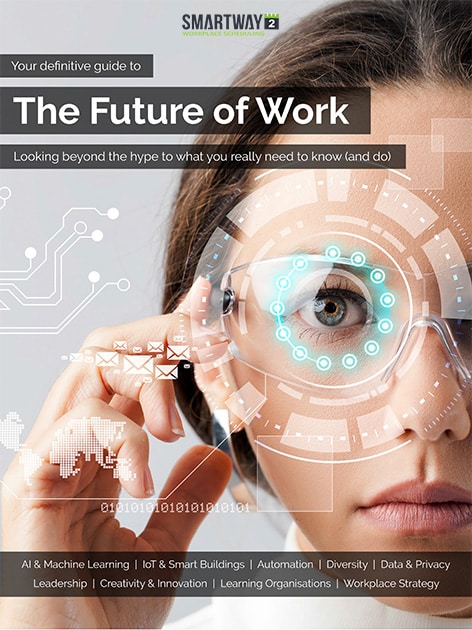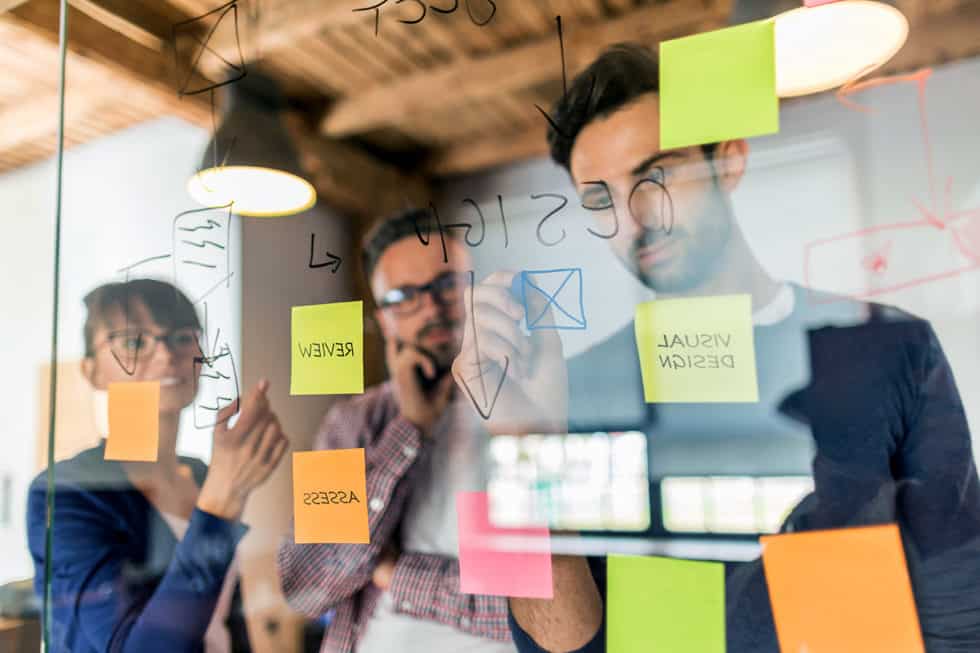
Agile Project Management & Design Thinking for Facilities Managers
Agile Facilities Management
As we talked about in this article on Transformational Facilities Management, FM is shaping up to be one of the most challenging, diverse business roles there is.
Organizations are redesigning the way they work in order to compete and respond to rapid changes in their marketplace; and Facilities professionals play a pivotal role in making it happen.
Advances in behavioural science have revealed the true extent to which workplace environment and agile, ‘work anytime any place’ approaches boost productivity. Now Facilities professionals face the daunting task of delivering the ideal workplace of the future.
To rise to this challenge, FMs need to find new ways to get things done.
Like many other disciplines, Facilities is turning to agile methodologies, for the answer.
In this article we’re going to explore how you, as a Transformational Facilities Manager, can blend agile project management with design thinking to supercharge your impact.
Both of these approaches are hailed as the current best way to deliver projects and solve problems; placing the ‘customer’ firmly at the center. When you put them together, you unleash the ultimate toolkit for rapid, continuous innovation.
The problem with Agile Facilities Management
Few would deny that traditional Facilities and HR practices fly in the face of agility. ‘Human Resources’ has been all about managing people as resources, while ‘Facilities Management’ has been all about managing physical infrastructure.
It’s no surprise that both disciplines stand accused of being stagnant and archaic. Such limited scope and traditional frameworks are no longer viable in an agile, digital world. Rather our workplaces are fast becoming more human. This means a shared focus on human experience, productivity, motivation and collaboration.
In truth, modern-day, Transformational Facilities Management is anything but stagnant and archaic. Today’s Facilities professionals stand on the bleeding edge of smart technology, data-led decision-making and culture change.
Boundaries are blurring between previously silo’d departments and disciplines, as we move into an era some call ‘People Operations’. An era that blends Facilities, HR and IT to deliver ideal conditions in which people can do their best work, whether in or out of the office.
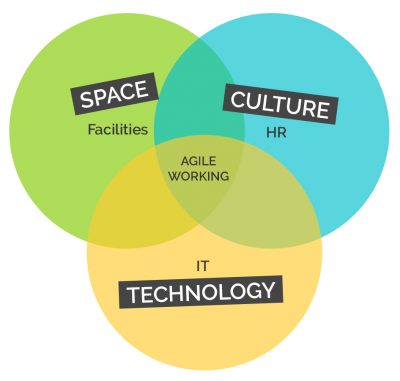
Facilities professionals are driving the shift towards agile working by delivering an integrated infrastructure that creates sustainable behaviour change in their organizations. They’re achieving this by moving beyond the realms of ‘one person per desk’ and waterfall project management, to drive an expertly choreographed, collaborative effort.
Download your free PDF guide to Agile Working here.
Ultimately, Facilities leaders benefit from adopting agile development processes because they are responsible for projects. They need to do more with less. From preventative maintenance to incoming work orders, Facilities must strike a balance between long-term projects and reactive, day-to-day problems that crop up.
So where do you begin?
Well, when you boil it down, all work gets done in just two ways:
- By completing projects
- By following processes
Traditional approaches to project management are too high risk in today’s VUCA (volatile, uncertain, complex, ambiguous) world. Not only that, they tend to focus on what the project owner wants, as opposed to the end user.
To create a superior employee experience, boost collaboration and increase productivity, focusing on the end user is essential. In fact you need to go a step further by involving end users.
This is where agile methodologies and design thinking, together, give you a serious advantage.
What is Agile Project Management
Agile project teams break their project down into small chunks called ‘iterations’, or ‘sprints’. These sprints are typically short and consistent (e.g. 2 weeks). During these chunks of time the team’s goal is to deliver something of value that can be released to end users, in order to get feedback.
That way you de-risk projects by continuously checking in, rather than heading down a wrong alley, unawares. This is essential due to the unpredictable conditions we’re operating within.
With an agile approach, you continuously involve the people whom you’re designing for in the process. As a Facilities Management professional, you’ll typically be designing for employees (though sometimes visitors or other members of the ecosystem).
When people are involved in co-creating their work environment, as opposed to having change dictated to them, they’re not only more likely to think favourably about the change, but about their organization as a whole. In fact end-user involvement is a critical missing link in most organizational change efforts, including FM. Perhaps that’s a big reason why projects fail more often than not.
A key difference between traditional waterfall and agile approaches is that with agile project management, work isn’t broken down into linear sequences (e.g. research, spec, design, build, test). Rather you have a collaborative, cross-functional team – e.g. HR, IT, comms, FM, Finance, Security, Risk, Interior Design – working together.
Before starting a sprint, teams prioritize problems, talk about potential solutions and assign tasks. At the end of the sprint, they review progress, exploring what worked, what didn’t, what challenges they came up against and therefore how they can improve processes for next time.
Here’s a summary of the benefits…
Why agile project management?
Agile is fast
Traditional projects typically have requirements spec’d out in meticulous detail, spanning months or years. Everything is thought through and researched at the outset. The project then passes through various stages, linearly, in one direction (hence the term ‘waterfall’).
In comparison to agile, this is a slow, inflexible process that leaves little room for reacting to change along the way. Often by the time the rubber hits the road, your original research or strategy is out of date. In contrast, agile project management is all about speed and flexibility. It allows you to get concepts in the hands of your end-users as quickly as possible.
Agile reduces risk
As we’ve touched on, a key part of the agile process is continuously checking-in with your customer / end user. This means you don’t risk spending months on end creating something that doesn’t fit end user needs. You find out early if you’re on the wrong track, so you can adjust course before you waste resources. That’s why you’ve probably heard a lot of talk about adopting a ‘fail fast’ mindset in recent years. Failure is an inevitable part of the innovation process – but it’s a good thing if you find out early, learn from it and create something better as a result.
Agile is collaborative
Unlike old-school linear project management, agile project teams don’t work in silos. Cross-functional teams continuously collaborate as they build, test, learn and iterate together. Likewise, you’re continuously working alongside the end user, co-creating solutions they can buy into.
Agile produces higher quality solutions
Since the process involves lots of testing along the way, it’s likely your solutions and changes will be of higher quality. You’ll also spend far less time fixing problems once they’re implemented.
Agile keeps costs in check
If you follow a traditional approach, it’s likely you’ll identify requirements that aren’t necessarily correct or important, based on assumptions you make early on. Agile, on the other hand, enables you to keep the scope of your projects flexible. This means you’ll only pay for what people really need, rather than what you think they might need. You can still work to a budget on agile projects, through careful prioritization.
Agile produces better outcomes
You’d hope that all projects would produce a useful outcome, but sadly this is not the case. The corporate (and private sector) world is rife with project failure. With agile, you have a far better shot at creating solutions that make a real impact and deliver what’s needed, because you’re always testing and releasing tangible chunks of your solution in order to learn and hone in on what works. The emphasis on getting real changes and experiments out into the world as you go – rather than looking at everything in plans or on paper – enables continuous improvement. The result is consistently successful outcomes.
Resistance to agile
It’s not uncommon for people to resist adopting agile project management methods. There can be a sense that you’re going to lose control. With traditional waterfall methods, everything is meticulously mapped out from the beginning. Certain personality types take great comfort in this, it’s human nature.
Yet let’s be clear: this is an illusion of control. The control is not real. In fact it’s a head-in-the-sand approach that purposefully ignores external realities. Unless you’re equipped with a crystal ball, it’s humanly impossible to predict what will happen during the course of any project; particularly a big, long one. That’s why true control comes from the responsiveness and adaptability that agile enables.
So now we’ve covered the ‘what’ and the ‘why’ of agile project management in Facilities, soon it’ll be time to explore the ‘how’.
But first, let’s dive into the basics of design thinking, so we can bring the two methodologies together to compliment one-another and improve the success of your Transformational FM efforts.
You’ll start to notice a degree of similarity between the two approaches, as they hinge on the same philosophies of customer-centricity and adaptability.
What is design thinking?
Design thinking is a creative process that draws from the designer’s toolkit, to solve problems and make innovation more successful.
Design thinkers question assumptions, collaborate and build prototypes as early as possible to test ideas and get feedback. It’s a practical, hands-on, action-orientated approach.
The old adage that organizations need to put people first can be turned into reality when design thinking is applied to the workplace.
The most impactful Facilities leaders constantly question how they can enable their colleagues to do their best work. This often comes down to removing barriers that stand in their way.
Design thinking processes enable you to uncover ways to create ideal conditions for the people in your organization, serving as a catalyst for behaviour change.
It’s little wonder that one of the most in-demand leadership traits today is emotional intelligence. EQ enables leaders to deeply explore and understand the needs and desires of others. This understanding is a vital part of the design thinking process.
Facilities leaders who work closely with their people to explore problems, refine concepts and play with prototypes, add tremendous value to their organizations.
Given Facilities Management is faced with evermore complex challenges in engaging and supporting a more agile, flexible workforce, you’ll benefit significantly from adopting a design thinking approach. It can transform the way your organization creates strategies, products, services and processes.
Raising the game in FM
Back in the day when Facilities was all about physical infrastructure, end-user needs were a relatively small part of the equation.
Yes, we needed to provide a safe, secure, reasonably comfortable space for employees to work in. Yet these days the workplace – encompassing the needs of team members who work anyplace – is nothing short of a differentiator. The workplace is a source of competitive advantage. It influences our ability to attract and retain talent. It determines whether people collaborate, or operate in silos. It impacts the productivity and success of our organization; its agility, sustainability and longevity.
Given the level of responsibility for organizational success that now sits on Facilities’ shoulders, it’s essential we begin to solve problems in new ways.
As for Design, as a discipline, it traditionally focused on aesthetic style, but in recent years has evolved to focus more heavily on the end user.
That’s why you’ll see examples of products that don’t look very ‘designed’ at all, but are highly usable and enormously successful. Google is a prime example.
This means that rather than designers coming up with solutions to problems, the process becomes more nuanced. These days they typically avoid coming up with a solution until they’ve fully explored the problem with the customer. They often reframe the problem and consider it from multiple perspectives. They look at a wider gamut of possible solutions, testing out different ideas and eliciting feedback along the way.
Modern solution designers in every discipline make fewer assumptions than their traditional counterparts. They expect to try multiple solutions before settling on the optimum way forward.
What’s more, design thinkers never see a solution as final. Everything can be iterated, improved upon and tinkered with. That way, even age-old problems can be approached with fresh thinking and a renewed desire not to settle.
When fully embraced, design thinking means we can say goodbye to static, legacy systems that hang around forever in our organizations, making life perpetually difficult and expensive.
Exploring big questions in Facilities Management
As a Transformational Facilities Manager, it’s likely you’re asking some big questions. How will we respond to the shifting expectations of top talent? How will we improve the agility and responsiveness of our organization? How will we create an exceptional experience for employees, visitors and other members of our ecosystem? How do we create a sustainable workplace of the future? How can we influence wellbeing, health and happiness? How will we introduce Agile Working, enabling people to work however, whenever and wherever they choose? How will we continuously improve productivity? How do we foster collaboration?
Design thinking is ideal for contemplating big questions like these, because it’s particularly useful for ‘wicked problems’: those that are ill-defined or tricky, where the problem itself is often as unclear as the solution.
The design thinker’s mindset
The design thinker’s mindset is playful, curious and inventive. We don our design thinking cap and become explorers and experimenters. Learners. We start with crazy ideas and search for ways to test them out. We tinker and tweak and prototype. We focus relentlessly on the person/people we’re designing for, deeply exploring and carefully listening to their pains, needs and desires. Listening out for what they don’t say. We stay open-minded and search for insights that validate or shut down our ideas.
Design thinkers are prepared to fail and create things that don’t work, as an inevitable part of the process. Again, we come back to the ‘fail fast’ mentality of agile thinkers. Negative feedback is often a gift, because it prevents us wasting resource on the wrong thing.
Using Design Thinking in Facilities Management
Say you find yourself using design thinking to solve problems as a Facilities professional – how’s about setting your sights even higher? What if you could take it upon yourself to instil a design thinking mindset across your entire organization? That’s what a Transformational FM would do, after all!
This would not only be an exercise in radical culture change, it’s likely to be a major contributor to your productivity, innovation and collaboration goals. Not to mention all your other goals, from talent attraction and retention to cost reduction and sustainability. Teams who use design thinking tend to solve problems faster and more effectively.
As with all change, there are two levels: personal and organizational. Change always demands that we each have our own individual lightbulb moments; otherwise transformation efforts fizzle out. Until people change the way they think and do, your organization as a whole will never change. After all, what is an organization, if it isn’t just a bunch of people?
Training your entire organization to embrace design thinking creates these lightbulb moments, both individually and collectively. Therein lies the power.
How to implement design thinking
Design thinking is a 5-step process:

- Empathise – dig into user behaviour: needs, desires and motivations. We often map out the user journey. This is a questioning, exploratory phase, when assumptions should be challenged and minds should remain open to new possibilities. Bring experts into the equation, talk to users, observe and work in groups to deepen your understanding of the problem. Drill as deeply as you can into user challenges and look at them from different angles. Try using the well-known jobs-to-be-done (JTBD) framework to help break down the detail. JTBD enables you to consider the 8 steps that every job involves, finding opportunities to improve the outcome at each point.
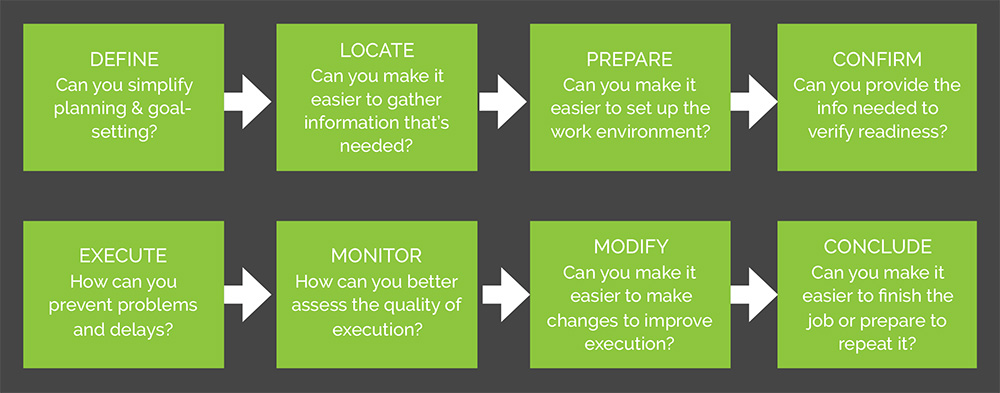
- Define – analyse the data you’ve gathered in step 1. Try to reduce it down to its essence. Clearly articulate the problem, based on the requirements of your users, within the constraints of your organization’s goals. The way you define the problem typically influences the solution, so be careful to frame it in a meaningful, inspiring, unequivocal way. These initial phases are all about understanding the user and their situation, so you can draw insight that’ll enable you to come up with more innovative solutions.
- Ideate – this is a highly creative phase, where you employ various techniques to generate possible solutions. Use mind-maps, decks of thought-provoking cards, brainstorming, sketching, creativity games… this is where imaginations run wild and various alternative solutions are identified. Logic is applied to these ideas to come up with unexpected ways to solve the problem you’ve articulated through the first two phases.
- Prototype – an important aspect of design thinking is to bring ideas to life via prototyping. This enables you to get more meaningful insights when you elicit feedback. Consider how you can make your idea real, so end users can experience it. Prototypes should be as fast to implement and as cheap as possible, to avoid waste.
- Test – learn from all the feedback you’ve gleaned and use these insights to iterate and improve the solution. Chances are you’ll revisit previous stages multiple times, on your mission to delight end users while exceeding business goals.
Design thinking in Facilities is a strategy for innovation. It’s nothing new: creatives have used techniques, tools and processes like this for years. The difference today is that the value of thinking like a designer is being recognised as universal. In other words, implementing design thinking in areas that haven’t traditionally been considered creative (Facilities!) – and even better, implementing design thinking organization-wide – is delivering extreme value for those who embrace it.
Just remember, sometimes problems can sound dull and uninspiring, e.g. to reduce costs or work orders. The level of energy people apply to solving the problem is heavily influenced by how it’s framed. Try to elevate your vision of what a solution would look like. Be visionary and outrageously ambitious. Think far ahead into the future, whether 2, 5, 10 or 20 years.
Write an article from the future
Some creatives and entrepreneurs use the technique of writing an article from the future. Imagine what the headline would be in the New York Times when this problem is solved and your solution implemented? What image would go with the article? What’s the story?
Look for inspiration in unexpected places
Always look for inspiration in unexpected places. Rather than relying on case studies from other organizations similar to yours for inspiration, look further afield.
It’s also best to avoid rigidly adhering to best practice. Copying what someone else has done seldom has the same result. There are too many variables. Instead, focus on best principles. Think of the adjectives that describe what you want the solution to represent. Perhaps it’s ‘fun’, ‘inspiring’, ‘fast’ – then look more broadly, in unexpected places, to find organizations, projects or other manifestations of these attributes.
Get your detective hat on, get out of the building and experience what you can: observing, exploring and searching for new possibilities. Document what you find, by taking photos, taking notes and gleaning inspiring examples. McDonalds and Formula 1 pitstops, for example, can teach you a whole lot about process and speed.
Just like ‘fail fast’, this ‘get out of the building’ mentality is a core belief perpetuated by lean startups. Now that every organization, regardless of size, is seeking to adopt a more entrepreneurial mindset, Facilities has the opportunity to lead the way.
If you need some creativity tools to use with your team, give Gamestorming a go.
How to implement agile project management
As for agile, there are many flavours of implementation. Most boil down to a process that mirrors the scientific method: hypothesizing, experimenting and evaluating.
You cycle through the same steps during each sprint, enabling you to respond to change along the way.
Typically these steps look something like this:
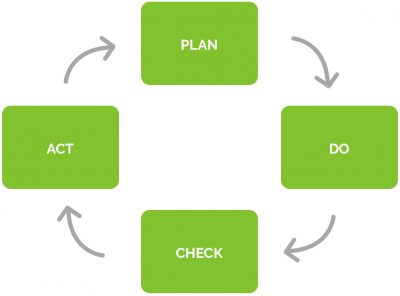
- Plan – Focus on the problem and what the output should be. Hold a kick-off meeting to make sure everyone is on the same page. Clarify things like who’ll be working on what and who signs off on the work. Set priorities by creating the project backlog, estimating the amount of work involved and putting it in order of priority. This phase can be thought of as designing ‘tests’, as a scientist would. Ask yourself ‘what can we deliver in this sprint that will validate or disprove our assumptions?’ Your project backlog is typically a collection of ‘user stories’. User stories originated in software development, but can be used in every discipline. The format goes: ‘As a [type of user], I want the ability to [do this thing] in order to [achieve this goal].’ Identifying and summarizing the needs of your end-users (most likely employees) in this format provides complete clarity on their needs.
- Do – Execute the plan, delivering something of value within the sprint. Collect the results.
- Check – At the end of a sprint, you’ll typically hold a sprint review meeting. This includes team members and end users or other stakeholders. The core purpose is to demonstrate what you came up with during the sprint. That way you can discuss possible improvements and if necessary, shuffle around priorities in the backlog. What happened vs your prediction? What did you learn? Analyse the data you’ve gathered, to broaden your insights (e.g. energy consumption, room and desk occupancy data; # meeting rooms released due to prompting people to confirm check-ins – watch this short video on ‘Smart Room Recovery’ to learn more).
- Act – Plan out the next sprint. Retrospectively examine what went well and what went wrong. Consider ways to improve your processes.
Many agile teams have a ‘daily standup’ meeting at the same time every day, lasting no more than 15 minutes. Everyone on the team answers 3 questions:
- What did you do yesterday?
- What are you going to do today?
- Is anything blocking you or do you need help?
That way collaborators never get stuck. The idea is to maintain full transparency and excellent communication throughout the project.
Just remember that you don’t need to rigidly adhere to anyone else’s process. If you fully grasp the underlying principles of agile, you’re free to adapt it however you see fit.
So now we’ve covered the implementation of design thinking and agile project management, let’s put it all together.
Bringing agile and design thinking together
One way to think about how agile and design thinking work together is this: agile is about solving problems through execution, while design thinking helps you think differently about which problems to solve and what sort of solutions might work.
As we’ve established, getting feedback and co-creating with end users is a vital part of the agile method. It enables us to correct our course, get new insights and refine our solutions, based on reality as opposed to assumptions.
However, showing a prototype, plan, picture or some other manifestation of our solution to our end user and simply asking what they think often won’t cut it. We need to take pains to ensure feedback is truly useful; and this is determined by our approach to eliciting that feedback.
Common problems when asking for feedback include:
- People don’t always feel they can talk candidly and critically
- People only respond to what they can see, feel and hear – which doesn’t always reflect their true needs or desires
- People don’t know what they don’t know – e.g. Steve Jobs always insisted on ‘skating to where the puck is going to be’. He couldn’t rely on simply asking people what they want, in order to innovate. He had to predict desires they didn’t know they had yet. Although we do want to remain practical in solving acknowledge pains, it doesn’t hurt to set our sights high and sprinkle some Jobs magic on FM.
This is where design thinking makes a huge difference. It enables you to ask better questions and draw out more meaningful insights. In turn this improves your decisions and ideas. That way your agile ‘sprints’ are more likely to produce something truly valuable to your end user.
You may wish to make your first sprint a ‘design thinking’ sprint. That way the entire team can fully immerse themselves in the problem.
You can begin to see how applying design thinking approaches – particularly in the Plan and Check phases of your agile lifecycle – will supercharge results. Equally you can whip out your design thinking toolkit whenever a tricky problem arises during a sprint.
Ultimately, the goal is to create a process that flows from idea to execution with as little resistance as possible, leaving room for continuous improvement. Thinking through the ways in which you can apply this combination of agile and design thinking in Facilities will increase productivity, profits and innovation.
Not to mention the fact that your organization and your role within it will become a whole lot more fun.
Download eBook: The Future of Work
Your definitive guide to the future of work. Looking beyond the hype to what you really need to know (and do). Topics include machine learning, smart buildings, automation and more!
